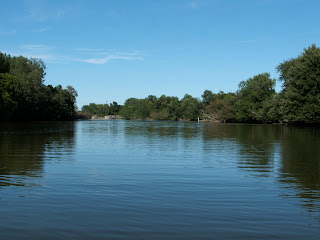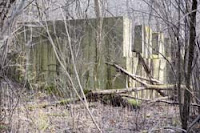This page is still under construction!
Component #1
There are two "welcoming points" for all users. These two trailheads have been identified as suiting the needs for parking, accessibility and ease of use.
#1 High Street Trailhead
(Above)
#2 Chapman Road
(Right)
 The Richmond Aqueduct (located at the end of Trail #2) is the highest ranking site. The remains of the aqueduct once carried the Enlarged or Second Erie Canal over the Seneca River. This stone structure was built in 1849, and was one of five large aqueducts put into use on the Erie Canal.
The Richmond Aqueduct (located at the end of Trail #2) is the highest ranking site. The remains of the aqueduct once carried the Enlarged or Second Erie Canal over the Seneca River. This stone structure was built in 1849, and was one of five large aqueducts put into use on the Erie Canal.  It was the second largest aqueduct having 31 arches, and spanned 894 feet across the Seneca River. Much of the structure was removed during the construction of the Barge Canal, but enough remains to tell the fascinating story of man verses nature.
It was the second largest aqueduct having 31 arches, and spanned 894 feet across the Seneca River. Much of the structure was removed during the construction of the Barge Canal, but enough remains to tell the fascinating story of man verses nature.
Component #3
The Seneca River Side will be an attraction to people, as most are drawn to water. There are many spots along the river that could be developed by clearing views, for boating and fishing access. Caution will be used not to cause erosion. It can be expected many will wish to view the aqueduct remains from the banks of the river. Simple seating could be also be provided by using available materials from the nearby woods. It is expected this area will flood over yearly and no permanent facilities are being planned for construction.
Component #4
Junction area and the old downtown area is part of the charm and history of Montezuma even though it is no longer there. Although this will not serve as a main attraction, it can be used to set the stage and tell the story of Montezuma. The old junction of the Erie and the Cayuga Seneca Canals remains fairly intact and is accessible. The Cayuga Seneca Canal was a lateral canal that served to connect Cayuga and Seneca Lakes to the Erie. From this point, boats could travel to Ithaca, Geneva, Watkins Glen, or even to Pennsylvania. Signage and maps could enhance this area.
Component #5
Lock 62 (located just north of the Lock 62 Trail entrance) on the east side of the Seneca River can be found hidden in the woods. It was on the first Erie Canal, and served to connect the canal to the river. From 1820 to 1853, boats had to cross the Seneca Rier on what is called "slack water pools," a dammed area of water deep enough for boats to safely float across the river. Before the building of the Cayuga Seneca Canal, boats could reach Cayuga Lake by way of this connection. The locktender lived in a house near the lock and remains of the foundation and well can be found north of the lock pit.
Component # 6
The remains of Lock 11 on the Cayuga Seneca (enter the site from Lock 11 Trail east of Chapman Road) is near the downtown area. These are the finest and best preserved remains of any of the 11 locks located on the canal.
Component #7
The park is not only rich in historical sites, but also contains beautiful natural wetlands. By providing a means to access these areas, it will attract people to the Park who may not have interest in historic site. A boardwalk and viewing platform will be needed as well as signage to help explain the wetlands to novices. (This will be located off of the C&S Lock 11 Trail east of Chapman Road),
Component #8

The Paper Mill site (located south of the Papermill Trail off Chapman Road) has the unique opportunity to tell a story that parallels and at the same time is opposite of the Federal Wildlife Refuge. It is the story of how the wetlands were used by man to build industry, and how man turned to the wetlands as a source of raw material when other natural sources had been exhausted. The remains of one such industry is on the southern bank of the canal, the Montezuma Fibre Mill. This industry harvested cattails from the wetlands and turned them into paper making fiber. It was built in 1906 and lasted but a few years, going bankrupt in 1914. Clearing of the site would allow access and help to slow the decay of the cement foundation.





